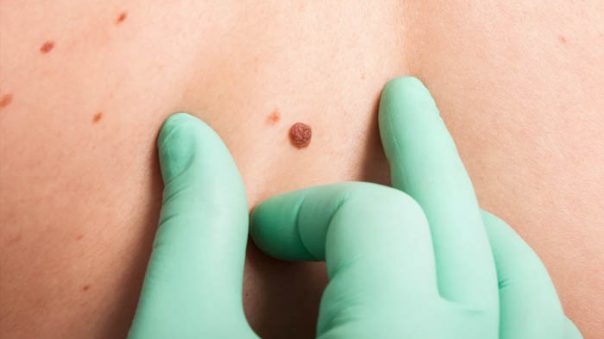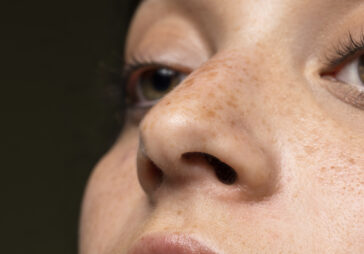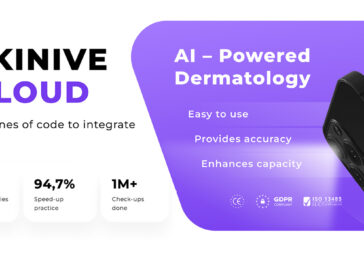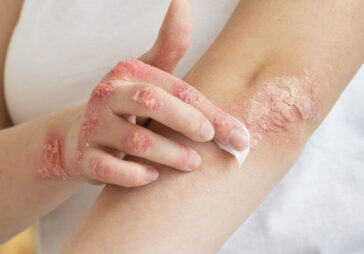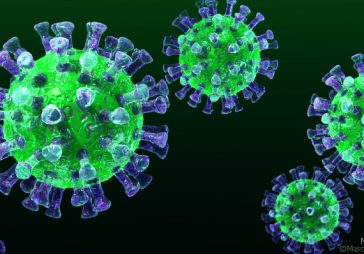While for many of us moles are just brown spots on our body we may not pay much attention to, they come in various shapes, sizes, and forms that can tell us important things about our skin health. Understanding all types of skin moles helps us identify any suspicious spots for skin cancer and keep our skin healthy.
Want to keep your skin healthy? Download free Skinive app to check your nevus for signs of skin cancer and get an instant risk indication.
First of all, what is a nevus?
A mole or nevus is a dark spot on our skin comprised of skin cells that have grown in a group rather than individually. These cells are called melanocytes and are responsible for producing melanin, the pigment (color) in our skin.
Nevus appear on our skin from sun exposure (ultraviolet radiation), or we are born with them. Although the number of moles varies from person to person, fair-skinned people generally have more moles due to lower amounts of melanin in their skin. The average number of nevuses for adults is between 10 and 40. Moles can even come and go with hormonal changes such as pregnancy or puberty.
Most people develop more nexuses on their skin naturally with age and sun exposure, and most of the time these are harmless. However, we need to conduct skin checks regularly (recommended monthly, especially there is a family history of skin cancer, or at least every three months) to check whether they have changed.
Download Skinive app now to scan skin health and get instant risk indication of skin cancer.
Types of skin moles
Not all nevuses are created equal. Here’s a quick guide to mole types and what they mean for your skin. We categorised moles based on time of development, placement on the skin, and typical or atypical symptoms. Based on this categorisation, moles can be described by multiple classifications. For example, you may have a common acquired junctional nevus or an atypical congenital nevus.
Benign nevus (Common)
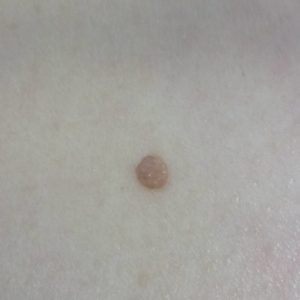
A common mole is usually about 5-6 mm large, has distinct edges, a smooth, dome-like surface, and pigmentation. Common moles are found on skin regularly exposed to the sun and can potentially but rarely turn into skin cancer.
Dysplastic nevus (Atypical)
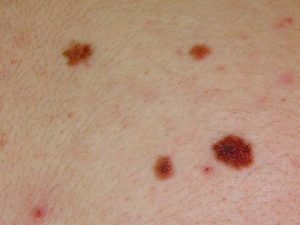
Atypical moles, or dysplastic nevi, are moles that exhibit irregular symptoms. They usually have fuzzy or blurry borders, vary in colour, are larger than most moles, and have both flat and raised components. While dysplastic nevi share a lot of the same signs of pre-cancerous or cancerous moles, most dysplastic nevi are benign. However, a person with many dysplastic nevi has an increased risk for skin cancer. Regular self-examinations are important to detect changes in these types of moles.
What is Skin Cancer?
Mole types by time
Congenital
Congenital moles, also known as congenital nevi, are moles that appear at birth or within the first year of a baby’s life. They are caused by melanocyte cells in the dermis (middle layer of skin), epidermis (outer layer of skin), or both. These types of moles can range in size and are sometimes referred to as birthmarks. Congenital nevi pose some risk of developing into melanoma later in life and should be monitored as you enter adolescence and adulthood.
Acquired
Acquired moles are nevuses that appear during childhood and adulthood. Most of these nevuses are benign and pose no risk, although sometimes they can turn into cancerous moles with age. This type of mole is the most common, and repeated sun exposure usually causes it.
Mole types by location
Junctional Melanocytic Nevi
Junctional melanocytic nevi are moles that occur from an accumulation of melanocytes where the dermis and epidermis meet. These nevuses are typically slightly raised with regular borders and dark pigmentation, although they can range in color from tan to dark brown. People usually acquire these nevuses between childhood and early adulthood, because, as we age, it is common for melanocytes to migrate down to deeper layers of the skin.
Intradermal Nevi
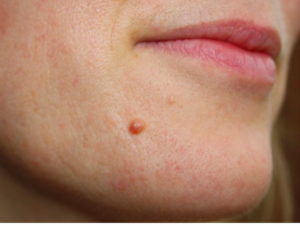
Intradermal nevi are skin-coloured moles that often blend in with your surrounding skin. Their pigmentation is not as dark as junctional melanocytic nevi because they are located in the dermis or the middle layer of your skin. These nevuses usually develop in late childhood or throughout adulthood and are very common and usually benign.
Compound Nevi
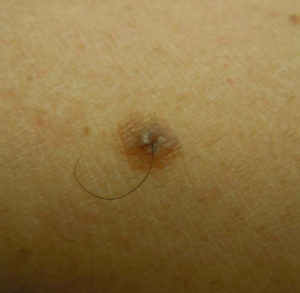
Compound nevi show signs of both intradermal and junctional nevi, with melanocyte cells located in the dermis and dermo-epidermis junction. These moles usually have a central raised area with flat areas around the edges. They usually have distinct borders and even pigmentation.
Other mole types to note
Halo Nevus
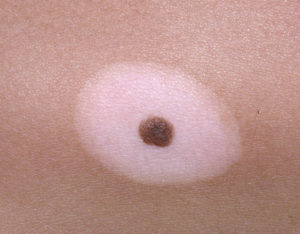
Halo nevi are raised moles surrounded by a ring of skin that has lost pigmentation due to inflammatory infiltrating cells. Doctors are still trying to understand why this reaction occurs, but if appropriately diagnosed, these moles are benign and require no treatment unless for cosmetic reasons.
How to know if your nevus is safe
Moles that are considered “safe”, or not at risk for cancer, generally have a few common features.
They usually resemble common moles and:
- have neat edges,
- are smooth or dome-shaped,
- are around ¼ inch (6 mm) in diameter,
- preserve the same shape, size or colour over time.
It is important to make an ‘inventory’ of your moles to recognize any changes that may occur over time. Understanding what is normal for your body is key to the identification of early skin cancer symptoms and in-time treatment.
Warning signs that it may be cancerous
Look for these indicators that your nevus may be cancerous:
- Changes in size (getting larger)
- A change in shape (especially with irregular edges)
- Colour changes (especially getting darker or exhibiting multiple shades)
- A loss of symmetry (common nevuses will be perfectly round or oval and are usually symmetrical)
- Itchiness, pain or bleeding (maybe even forming a scab)
- Crustiness
- Inflammation
- Exhibiting three different shades of brown or black
- A change in elevation (thickening or raising of a flat nevus)
If you notice any of these symptoms, contact a doctor to examine your nevus.
Skin cancer pictures
ABCDE rule of Moles
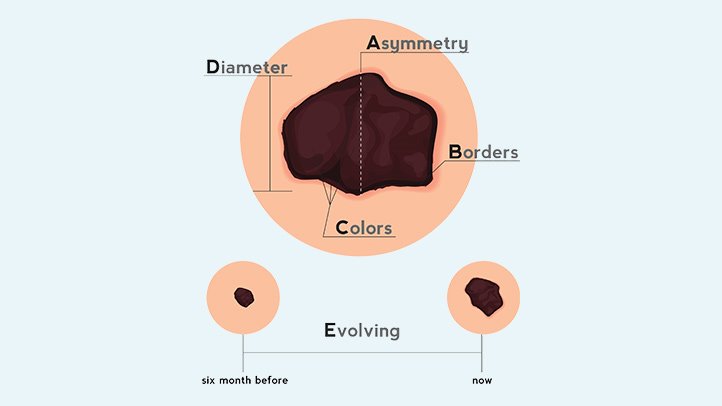
Remembering all of the things to look out for during a skin check can be difficult: this is why doctors advise using the ABCDE method to make things simpler. Check your skin for these signs during self-examinations:
Asymmetrical – the mole is distinctly asymmetrical
Border – the mole has uneven borders
Colors – the mole contains at least two distinct colours
Diameter – the mole is bigger than ¼ inch or 6 mm across
Enlargement – the mole grows in size over time

